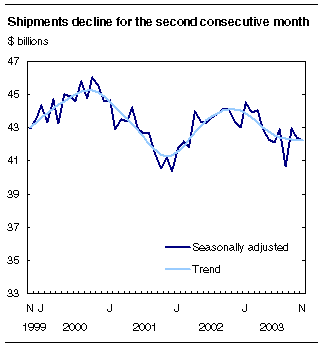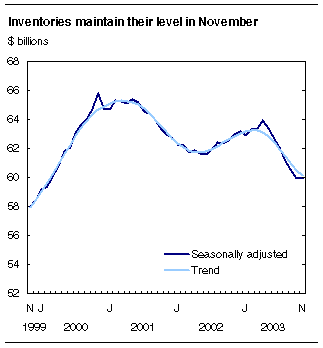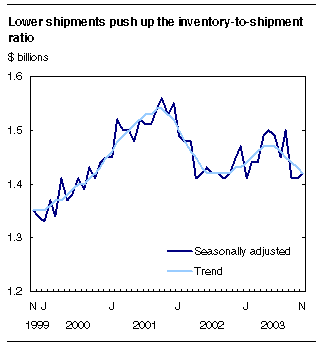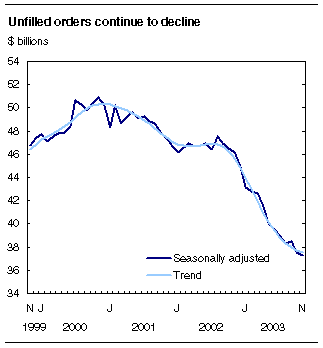
















 |
|
 |                |
Information identified as archived is provided for reference, research or recordkeeping purposes. It is not subject to the Government of Canada Web Standards and has not been altered or updated since it was archived. Please "contact us" to request a format other than those available.

|

Wednesday, January 21, 2004 Monthly Survey of ManufacturingNovember 2003In November, motor vehicle manufacturing dragged down total shipments by 0.5% to $42.2 billion, the second consecutive decline. Excluding the recently volatile motor vehicle and parts industries, shipments edged up a modest 0.1%. Only 9 of the 21 manufacturing industries, accounting for 57% of total shipments, posted decreases in November. Although the majority of manufacturers reported higher shipment activity during the month, most increases were modest. Ontario's manufacturers reduce shipments againManufacturing in Ontario retracted by $353 million (-1.6%) to $22.3 billion, leading the four provinces and territories that reported lower shipments in November. A slowdown in motor vehicle manufacturing, coupled with decreases in shipments of petroleum and food, contributed to Ontario's third decline in the last four months.
Quebec manufacturers reported a $15.9 million (-0.2%) decline in shipments to $9.7 billion, mostly the result of decreases in production of aerospace products and food. Fewer shipments of transportation equipment and fabricated metal products contributed to Manitoba's $15.6 million (-1.6%) decline in November.
US manufacturers outpace CanadaThe SARS virus, BSE (mad cow disease), forest fires, and the soaring value of the dollar Canadian were among several hurdles facing the Canadian economy in 2003. In the first 11 months of the year, shipments declined 1.3% from the same period of 2002. This was in sharp contrast to the United States, Canada's largest trading partner. Following sluggish economic growth in recent years, several sectors of the US economy, manufacturing included, posted strong gains in 2003. From January to November, US shipments rose 2.2% from 2002, increasing in six of the last seven months. Unfilled orders have been on a steady rise since August. While the US economy appears to be on the road to recovery, there are concerns that the strengthening value of the Canadian dollar may curb demand for Canada's manufactured goods. In November, the dollar closed in on a ten-year high of 77 cents against the US greenback, up almost 20% since the start of the year. Just over 50% of Canada's manufactured outputs are destined for international markets. Job growth weakened in 2003According to the year-end report of the Labour Force Survey, manufacturers hired fewer employees in 2003. Since November 2002, the number of manufacturing jobs declined by 82,000 (-3.5%), losses that were largely concentrated in Quebec and Ontario. On a monthly basis, manufacturing employment edged down 0.2% (-4,100 jobs) in December, following November's 1.0% boost. At year's end, there were just under 2.3 million people employed in Canadian factories. Fewer motor vehicles and aircraft manufactured in NovemberManufacturers of motor vehicles reported a 3.6% drop in shipments to $4.8 billion in November, the second decline in a row. Some assembly plants were temporarily closed for retooling, while others faced production slowdowns for inventory control measures. Year-to-date shipments are down 5.8% from 2002. 
Other industries reporting lower shipments included aerospace products and parts (-11.6%), food (-1.6%) and motor vehicle parts (-2.8%). Partly offsetting the overall decline in total manufacturing, shipments of petroleum and coal products rose 2.2% to $2.8 billion in November. Higher sales of petroleum products for the winter season contributed to the first increase since August. Boosts in manufacturing of machinery (+3.0%) and computers (+3.8%) also contributed to counteracting November's overall decline. Inventories remain steadyFollowing six consecutive declines, manufacturers held inventories constant at $59.9 billion in November, the lowest level since February 2000. As the year draws to a close, inventories may be bottoming out, as the rate of depletion has slowed in recent months. Inventories are down 6.2% since the latest high of $63.9 billion in April. 
By stage of fabrication, raw materials inventories continued an eight-month decline, falling 0.6% to $25.9 billion. This was offset by November's 1.1% rise in goods-in-process inventories, ending a six-month slide. Meanwhile, finished-product inventories were largely unchanged at $18.9 billion. Higher inventories of chemical products (+2.1%) and primary metals (+1.2%) were offset by declines in the computer (-1.5%) and railroad rolling stock industries (-5.3%). The inventory-to-shipment ratio advances slightlyNovember's decrease in shipments contributed to the slight rise in the inventory-to-shipment ratio to 1.42 from October's 1.41. Despite November's upward movement, the ratio has been trending down during the second half of 2003, as manufacturers continued their efforts to keep fewer inventories on hand, despite some erosion in shipment activity. The finished-product inventory-to-shipment ratio remained stable at 0.45 for the second consecutive month. This ratio is a measure of the time that would be required in order to exhaust finished-products if shipments were to remain at their current level. 
Fewer orders on the booksDespite the recent strength of the US economy, Canadian manufacturers posted a 0.8% drop in unfilled orders in November. Total unfilled orders were $37.2 billion, the lowest level in over six years. Contract cancellations and continued weak sales were reported by some industries, as the Canadian dollar soared to a 10-year high during the month. Leading all industries, unfilled orders of the aerospace products and parts fell another 3.2% to $10.5 billion in November. Orders have declined in 25 of the last 26 months, as ongoing weakness in the commercial aircraft sector continued to besiege the aerospace industry. Excluding the aerospace products and parts industry, total unfilled orders edged up 0.1%. Following September's big boost in unfilled orders of computer products, manufacturers in the high tech sector have lost ground in recent months. Orders fell back sharply in October (-6.4%) and November (-4.1%). Offsetting some of the decline, increases in unfilled orders were reported by the plastics and rubber products (+13.7%) and machinery (+1.2%) industries. 
New orders riseA bright note in November's report, manufacturers indicated a 1.0% increase in new orders to $41.9 billion. New orders have increased in four of the last six months, and the trend continued to gradually improve. The rise in new orders was wide reaching, including the plastics and rubber products, machinery and computer industries. Available on CANSIM: tables 304-0014 and 304-0015. Definitions, data sources and methods: survey number 2101. The November 2003 issue of the Monthly Survey of Manufacturing (31-001-XIE, $17/$158) will be available soon. Data for shipments by province in greater detail than normally published may be available on request. All data are benchmarked to the 1998 Annual Survey of Manufactures. Data from the December 2003 Monthly Survey of Manufacturing will be released on February 13. For general information or to order data, contact the dissemination officer (1-866-873-8789; 613-951-9497; fax: 613-951-9499; manufact@statcan.gc.ca). To enquire about the concepts, methods or data quality of the release, contact Russell Kowaluk (613-951-0600; kowarus@statcan.gc.ca), Manufacturing, Construction and Energy Division.
| ||||||||||||||||||||||||||||||||||||||||||||||||||||||||||||||||||||||||||||||||||||||||||||||||||||||||||||||||||||||||||||||||||||||||||||||||||||||||||||||||||||||||||||||||||||||||||||||||||||||||||||||||||||||||||||||||||||||||||||||||||||||||||||||||||||||||||||||||||||||||||||||||||||||||||||||||||||||||||||||||||||||||||||||||||||||||||||||||||||||||||||||||||||||||||||||||
|
|
|